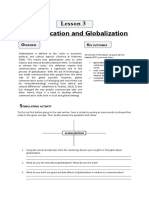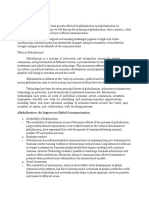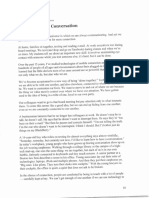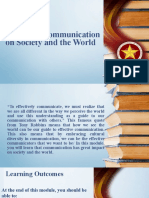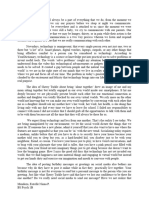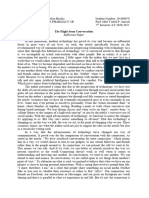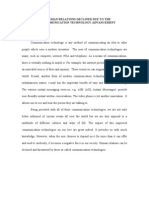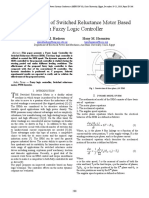Chapter 2
Communication and Globalization
Learning Outcomes
At the end of this chapter, the students are
expected to:
1. Define clearly the terms necessary in
understanding communication and
globalization;
2. Enumerate the causes of globalization
3. Discuss the impact of globalization on cross
– cultural communication;
Communication and Globalization
1
� As discussed in the previous chapter,
communication is a systematic process of reaching
mutual understanding, in which participants not only
exchange (encode-decode) information, news,
opinions, and feelings but also create and share
meaning. In general, communication is a means of
connecting people or places.
Meanwhile, globalization is the
interconnectedness and integration of the world’s
culture and economy, and infrastructure. This occurs
through transnational trade and investment, rapid
spread of information and communication
technologies (ICT), and the impacts of free-markets
on local, regional, and national economies. Key
players negotiate the exchanges of human capital,
the allocation and distribution of financial resources,
the fair exchange of goods and services, and the flow
of shared information in a borderless world.
Globalization has also affected how people
communicate. The picture below gives you a glimpse
of how technological tools of communication are
controlling human lives. People now live in a
sophisticated world in which communication is often
done with laptops, iPods, and multiple phones. And
yet, conversation has been sacrificed for mere
connection. Wherever and whenever human
activities take place, communicators, seem to be
more confident and satisfied with their work
performance and outputs when done with those
devices.
2
� (Source: https://www.nytimes.com)
At home, spouses and children sit together,
texting and reading e-mails. At work, executives and
employees text during meetings. In schools, students
communicate with their classmates and even with
their teachers through texts or through the
Messenger and other forms or social media. Several
entrepreneurs advertise their products online while
shoppers order and purchase goods online as well.
Some meet new friends through Twitter. Relatives
and long-time acquaintances get in touch through
Viber, Skype, or Instagram. Business partners across
borders engage in negotiations through
teleconferencing. Employers around the world
interview their job applicants through Zoom.
Researchers review related literatures through
Google. These and many more are manifestations
that globalization has influenced communication
skills development.
Below is the transcript of Sherry Turkle’s
(2012) speech at TedTalk.com. She is a psychologist
and professor at MIT who has been studying the
effects of mobile technology for the last 15 years.
3
� The Flight from Conversation
We live in a technological universe in which we
are always communicating. And yet we have
sacrificed conversation for mere connection.
At home, families sit together, texting and
reading e-mail. At work executives text during board
meetings. We text (and shop and go on Facebook)
during classes and when we’re on dates. My students
tell me about an important new skill: it involves
maintaining eye contact with someone while you text
someone else; it’s hard, but it can be done.
Over the past 15 years, I’ve studied
technologies of mobile connection and talked to
hundreds of people of all ages and circumstances
about their plugged-in lives. I’ve learned that the
little devices most of us carry around are so powerful
that they change not only what we do, but also who
we are.
We’ve become accustomed to a new way of
being “alone together.” Technology-enabled, we are
able to be with one another, and also elsewhere,
connected to wherever we want to be. We want to
customize our lives. We want to move in and out of
where we are because the thing we value most is
control over where we focus our attention. We have
gotten used to the idea of being in a tribe of one,
loyal to our own party.
Our colleagues want to go to that board
meeting but pay attention only to what interests
them. To some this seems like a good idea, but we
can end up hiding from one another, even as we are
constantly connected to one another.
A businessman laments that he no longer has
colleagues at work. He doesn’t stop by to talk; he
doesn’t call. He says that he doesn’t want to
interrupt them. He says they’re “too busy on their e-
mail.” But then he pauses and corrects himself. “I’m
not telling the truth. I’m the one who doesn’t want to
4
�be interrupted. I think I should. But I’d rather just do
things on my BlackBerry.”
A 16-year-old boy who relies on texting for
almost everything says almost wistfully, “Someday,
someday, but certainly not now, I’d like to learn how
to have a conversation.”
In today’s workplace, young people who have
grown up fearing conversation show up on the job
wearing earphones. Walking through a college library
or the campus of a high-tech start-up, one sees the
same thing: we are together, but each of us is in our
own bubble, furiously connected to keyboards and
tiny touch screens. A senior partner at a Boston law
firm describes a scene in his office. Young associates
lay out their suite of technologies: laptops, iPods and
multiple phones. And then they put their earphones
on. “Big ones. Like pilots. They turn their desks into
cockpits.” With the young lawyers in their cockpits,
the office is quiet, a quiet that does not ask to be
broken.
In the silence of connection, people are
comforted by being in touch with a lot of people —
carefully kept at bay. We can’t get enough of one
another if we can use technology to keep one
another at distances we can control: not too close,
not too far, just right. I think of it as a Goldilocks
effect.
Texting and e-mail and posting let us present
the self we want to be. This means we can edit. And
if we wish to, we can delete. Or retouch: the voice,
the flesh, the face, the body. Not too much, not too
little — just right.
Human relationships are rich; they’re messy
and demanding. We have learned the habit of
cleaning them up with technology. And the move
from conversation to connection is part of this. But
it’s a process in which we shortchange ourselves.
Worse, it seems that over time we stop caring, we
forget that there is a difference.
We are tempted to think that our little “sips” of
online connection add up to a big gulp of real
5
�conversation. But they don’t. E-mail, Twitter,
Facebook, all of these have their places — in politics,
commerce, romance and friendship. But no matter
how valuable, they do not substitute for
conversation.
Connecting in sips may work for gathering
discrete bits of information or for saying, “I am
thinking about you.” Or even for saying, “I love you.”
But connecting in sips doesn’t work as well when it
comes to understanding and knowing one another. In
conversation we tend to one another. (The word
itself is kinetic; it’s derived from words that mean to
move, together.) We can attend to tone and nuance.
In conversation, we are called upon to see things
from another’s point of view.
FACE-TO-FACE conversation unfolds slowly. It
teaches patience. When we communicate on our
digital devices, we learn different habits. As we ramp
up the volume and velocity of online connections, we
start to expect faster answers. To get these, we ask
one another simpler questions; we dumb down our
communications, even on the most important
matters. It is as though we have all put ourselves on
cable news. Shakespeare might have said, “We are
consum’d with that which we were nourish’d by.”
And we use conversation with others to learn
to converse with ourselves. So our flight from
conversation can mean diminished chances to learn
skills of self-reflection. These days, social media
continually asks us what’s “on our mind,” but we
have little motivation to say something truly self-
reflective. Self-reflection in conversation requires
trust. It’s hard to do anything with 3,000 Facebook
friends except connect.
As we get used to being shortchanged on
conversation and to getting by with less, we seem
almost willing to dispense with people altogether.
Serious people muse about the future of computer
programs as psychiatrists. A high school sophomore
confides to me that he wishes he could talk to an
artificial intelligence program instead of his dad
6
�about dating; he says the A.I. would have so much
more in its database. Indeed, many people tell me
they hope that as Siri, the digital assistant on Apple’s
iPhone, becomes more advanced, “she” will be more
and more like a best friend — one who will listen
when others won’t.
During the years I have spent researching
people and their relationships with technology, I
have often heard the sentiment “No one is listening
to me.” I believe this feeling helps explain why it is
so appealing to have a Facebook page or a Twitter
feed — each provides so many automatic listeners.
And it helps explain why — against all reason — so
many of us are willing to talk to machines that seem
to care about us. Researchers around the world are
busy inventing sociable robots, designed to be
companions to the elderly, to children, to all of us.
One of the most haunting experiences during
my research came when I brought one of these
robots, designed in the shape of a baby seal, to an
elder-care facility, and an older woman began to talk
to it about the loss of her child. The robot seemed to
be looking into her eyes. It seemed to be following
the conversation. The woman was comforted.
And so many people found this amazing. Like
the sophomore who wants advice about dating from
artificial intelligence and those who look forward to
computer psychiatry, this enthusiasm speaks to how
much we have confused conversation with
connection and collectively seem to have embraced
a new kind of delusion that accepts the simulation of
compassion as sufficient unto the day. And why
would we want to talk about love and loss with a
machine that has no experience of the arc of human
life? Have we so lost confidence that we will be there
for one another?
WE expect more from technology and less from
one another and seem increasingly drawn to
technologies that provide the illusion of
companionship without the demands of relationship.
Always-on/always-on-you devices provide three
7
�powerful fantasies: that we will always be heard; that
we can put our attention wherever we want it to be;
and that we never have to be alone. Indeed our new
devices have turned being alone into a problem that
can be solved.
When people are alone, even for a few
moments, they fidget and reach for a device. Here
connection works like a symptom, not a cure, and
our constant, reflexive impulse to connect shapes a
new way of being.
Think of it as “I share, therefore I am.” We use
technology to define ourselves by sharing our
thoughts and feelings as we’re having them. We
used to think, “I have a feeling; I want to make a
call.” Now our impulse is, “I want to have a feeling; I
need to send a text.”
So, in order to feel more, and to feel more like
ourselves, we connect. But in our rush to connect, we
flee from solitude, our ability to be separate and
gather ourselves. Lacking the capacity for solitude,
we turn to other people but don’t experience them as
they are. It is as though we use them, need them as
spare parts to support our increasingly fragile selves.
We think constant connection will make us feel
less lonely. The opposite is true. If we are unable to
be alone, we are far more likely to be lonely. If we
don’t teach our children to be alone, they will know
only how to be lonely.
I am a partisan for conversation. To make room
for it, I see some first, deliberate steps. At home, we
can create sacred spaces: the kitchen, the dining
room. We can make our cars “device-free zones.” We
can demonstrate the value of conversation to our
children. And we can do the same thing at work.
There we are so busy communicating that we often
don’t have time to talk to one another about what
really matters. Employees asked for casual Fridays;
perhaps managers should introduce conversational
Thursdays. Most of all, we need to remember — in
between texts and e-mails and Facebook posts — to
listen to one another, even to the boring bits,
8
�because it is often in unedited moments, moments in
which we hesitate and stutter and go silent, that we
reveal ourselves to one another.
I spend the summers at a cottage on Cape Cod,
and for decades I walked the same dunes that
Thoreau once walked. Not too long ago, people
walked with their heads up, looking at the water, the
sky, the sand and at one another, talking. Now they
often walk with their heads down, typing. Even when
they are with friends, partners, children, everyone is
on their own devices.
So I say, look up, look at one another, and let’s
start the conversation.
Source:
http://www.nytimes.com/2012/04/22/opini
on/sunday/the-flight-from-
conversation.html?_r=0
Impact of Globalization on Communication
The impact of globalization on communication
is observed in the following: creation of a global
village, cultural awareness in verbal and nonverbal
communication, provision of a worldwide platform for
more business opportunities, increase of business
opportunities, understanding of cultural diversity,
breakdown of cultural barriers.
Creation of a global village. Global village
refers to the world viewed as a community in which
distance and isolation have been dramatically
reduced by electronic media. People are connected
by computers, television, cell phone, the Internet,
etc., and all depend on one another. The term was
coined by Herbert Marshall McLuhan, a Canadian
communications theorist. The accessibility and
widespread use of social media facilitate the
exchange of ideas treating everyone like a neighbor,
instead of stranger. Thus, interdependence results.
As such, communication skills are developed;
9
�economic, social, and political relations are
established and strengthened.
Cultural awareness in verbal and
nonverbal communication. Business executives,
academicians, entrepreneurs, and employees need
to develop the ability to catch subtle nuances of
people’s manner of speech when communicating
across cultures. Even when two people are speaking
the same language, cultural differences can affect
the vocabulary, colloquial expressions, voice tone,
body language, speaking distances, facial
expressions, gestures, and eye contact.
Creation of more business opportunities.
Global interactions provides a platform that allows
business-minded persons across cultures to improve
their collaboration, to exchange ideas, and to pursue
new and unexplored opportunities across the world.
For instance, virtual interactions through video
calling make it simple to converse with colleagues
and foreign partners, almost making it feel as if they
are in the same room. This kind of communication
technology provides information up/down of
international market, where business opportunities
can prosper and improve the economic outlook on a
global level.
Understanding of cultural diversity.
Globalization provides a transparent perspective and
a clearer understanding of cultural diversity.
Diversity is the condition of having or being
composed of differing elements such as customs and
traditions, norms, age, gender, race, ethnicity,
religion, education, marital status, sexual orientation,
income, cuisine, and others. Globalization promotes
the flow of these elements cultural customs,
practices, and norms along with cross-border
exchanges of goods and services. However, both
individuals and organizations need to grasp the
cultural implications of these flows to get the most
10
�out of intercultural interactions. People must remain
interconnected in a global manner. For at the end of
the day, individuals who communicate and share
meaning and understanding also acknowledge
others’ differences; they also find similarities,
particularly when there are common goals –
production and quality.
Breakdown of cultural barriers.
Globalization has opened the doors for cultural
exchange in several areas of concern such as but not
limited to the following:
•science (e.g., research on new theories),
•arts (e.g., green architecture),
•technology (e.g., innovation of machines),
•philosophy (e.g., green economy)
•religion (e.g., Islam)
•music (e.g., alternative music)
•language (e.g., Mandarin)
Globalization has made it possible to break
down cultural barriers and to encourage the flow of
goods, services, capital, and labor. For example,
through social-political-economic relations of their
governments, many Asian workers like Filipinos,
Indonesians, Vietnamese, and others enjoy their jobs
(as teachers, nurses, caregivers, carpenters,
engineers, etc.) overseas; American tourists feast on
Chinese foods in Hongkong; Japanese technology
experts are invited to showcase their skills and
talents in Bangladesh.
Generally, through movies and television,
practices are perceived; some are adopted or
modified while others are simply ignored or rejected.
Nonetheless, cultural barriers are becoming less
prevalent. This is made possible by peoples’
exposure to multimedia and proper education.
Adopting awareness and recognizing persons and
contexts across cultures help people understand one
another much better.
11
� Relevance to education. In the area of
education, human interactions play an important role
in the convergence of talents and skills along the
following: (1) theories of teaching and learning, (2)
models of educational organizations, (3) key
competencies, (4) educational research and
development, (5) information and communication
technologies (ICT), and (6) development and use of
innovative instructional materials. These and other
needs of education are realized through the
collaboration of education experts. They come and
work together through scientific conferences,
seminars, training, and various academic fora to
share new ideas, experiences, best and tested
practices, to experiment new didactic models, to
suggest new competencies and skills.
Creation of competitive advantage.
According to Matthews and Thakkar (2011), to
become a global leader, one must possess cultural
intelligence— the ability “to navigate through
different cultural nuances.” Global leaders train to
communicate across borders in order to achieve
results. They must be proficient in using various
forms and tools of communication, including
multimedia, to be able to bring across effectively the
meaning of their messages. They must sustain
interactions with others from diverse cultural
backgrounds, while being aware of their own
personal cultural values that drive their attitudes,
behaviors, and beliefs. They must be willing to
change their opinions by learning from those that are
different from them.
Today, it is imperative to understand the
impact of globalization on crossculture
communication. If you seek to create or to be a part
of a competitive advantage in the global market, you
must embrace the technological changes and
challenges that come your way. As Genevieve Hilton
12
�has said, “cultural proficiency doesn’t mean
memorizing every cultural nuance of every market.
It’s knowing when to listen, when to ask for help, and
when—finally—to speak.”
Effects of Communication to Globalization
Communication technology has precipitated
globalization. First, it has created a global village,
a community where transnational individuals can
interact freely, quickly, and conveniently even
without meeting face-to-face. For instance, ICT
systems and devices are being used in order to
engage in business, to access or disseminate
information or research results, to obtain education,
to seek employment in foreign lands, to provide
entertainment, to advertise, sell, and purchase
products.
Second, communication technology
improved political relations among
governments in the world. Efficient and effective
management of communication enables
transnational governments to exchange data,
discuss policy analyses, and share sensitive security
reports with one another on a realtime basis. This
has led to transparent understanding and better
collaboration between and among nations. To a
certain extent, this harmonious relationship is
advantageous in bringing about peace and order
between conflicting regions and countries.
Third, cross-cultural communication
address the social needs of people around the
world. For instance, students can now access
information through Internet. Students can now get
certifications from foreign Universities by completing
an online program. These innovations have brought a
marked difference to the way education is imparted
and has led to an improvement in the quality of
education. Also, the campaign for financial
13
�assistance to feed, to clothe, to provide shelter to,
and to treat the illnesses of poor refugees of warring
countries and of victims of calamities across cultures
brings to fore the goodness of humanity. In addition,
the case of overseas workers cannot be undermined;
they work in foreign lands and sacrifice to be
separated from their loved ones in order to earn
good income to support the needs of their families.
Fourth, cheaper online-only sources in
providing national and international
information has become pervasive. Internet
sources, which include the World Wide Web sites,
have become so extensive and rapid that they have
even overtaken print media. Likewise, transnational
information that are read from expensive journals,
books, and magazines (e.g., history and geography,
cuisines, sports, innovations, lifestyles, discoveries,
life and works of great personalities, disasters and
calamities, flora and fauna, socio-eco-political events
and issues, entertainment highlights, etc.) can be
accessed readily by viewing them on CNN, BBC,
Channel Asia, and Al Jazeera, and other television
channels. Consequently, newspapers and other
reading materials have lost their appeal and are
likely to disappear in the information highway.
Fifth, effective communication channels
have led to the globalization of banking
industry. Nowadays leading banks from all over the
world now have their offices in almost every country
of the world. A number of prominent citizens even
deposit their wealth in banks abroad for security
reasons.
Sixth, the information highway has
universalized the transmission and influence of
popular culture. Pop culture is a set of dominant
cultural products (e.g., pop music and dance, fast
foods, hip-hop fashion, indie films, hunger games,
Marvel movies), practices (e.g., selfie, garden
14
�wedding, same-sex marriage), politics (e.g.,
espousing dystopia as a future form of government),
language (e.g., street English, slang), business (e.g.,
Zalora and Amazon online transactions, ATM
transaction), and places (e.g., virtual libraries and
museums) in a society at a given point in time. Such
pop culture is more extensive and ubiquitous among
the masses. In contrast, the ‘official culture’ of the
elite embraces the fine arts, theater, fine dining,
opera, higher education, and other intellectual
pursuits that are not accessible to the lower class of
society. To which culture do you belong?
Meanwhile, side by side with the good impact
of communication on globalization come certain
challenges. There is a wide disparity when it comes
to access to technology between developing nations
(like the Pakistan and Nigeria) and developed nations
(like China and the United States). The developing
nations do not have adequate and efficient facilities
and proper infrastructure in place. For instance,
access to Internet connection is so slow in the
Philippines, while in South Korea, every household
enjoys quick Internet connection. Opening the
economy to foreign investment can substantially
improve communication services and promote
healthy competition. Providing the needed
atmosphere for foreign investment can spur
development not only in communication but in all
dimensions of human endeavor. Institutional policies
on security, ease of doing business, sanctity of
contractual rights and obligations are essential in
attracting foreign investments.
In the light of the foregoing discussion, it is
important to consider necessary corrective measures
that would alleviate the sufferings of the neglected
members of society. Issues and concerns on
inequality in communication technology can be
countered by undertaking development programs
15
�and projects that would cater to the interests and
needs of the global community.
To commmunicate effectively,
we must realize that we are all different
in the way that we perceive the world
and use this understanding as a guide to our
communication with others.”
-- Anthony Robbins
16

